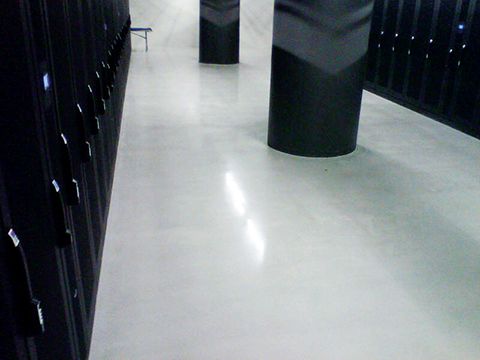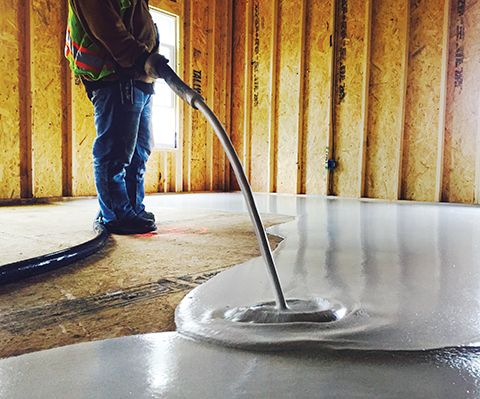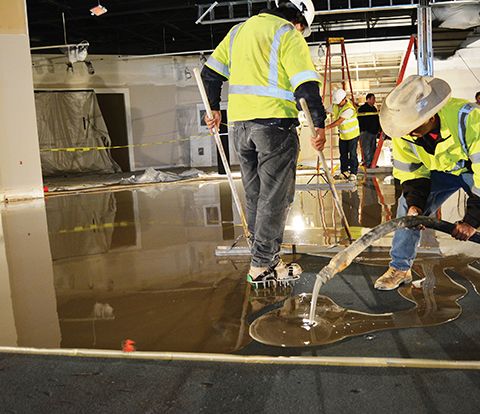
Aggregates
The introduction of an aggregate such as sand to the hemihydrate slurry will reduce the strength of the hardened mass because it spreads the new hydrated gypsum crystals apart. Sand also prevents the new hydrated gypsum crystals from growing into each other. Further, the sand does not chemically bond to the newly formed crystals; instead, the sand becomes trapped and locked within the crystal matrix.
Since sand is added to most gypsum cements, special attention must be paid to the quantity and type of sand that will help the slab meet the designed specification. One way to maximize how sand integrates with the slurry is to make sure the particles range in size and shape. Sand that is too angular and flat is not as good as sand that has a rounded shape. Sands that have a more rounded shape tend to ‘roll’ more than flat-shaped sand. This is important when trying to control the flow and leveling characteristics of the slurry.
Ultimately, given the rules previously described, one can deduce that excess water and the resultant negative effects of crystal growth will result in ‘soft’ or ‘chalky’ gypsum concrete floors.
In the last 15 years, advancements in formulations and more stringent installation procedures have improved the quality of gypsum-based levelers to the point where installed characteristics can exceed those of traditional PC and HAC products. Gypsum levelers in today’s market can be mixed to meet or exceed industry standards as being a suitable substrate for all types of floor coverings. Current technology can create hydrated products achieving compressive strengths that approach 137,800 kPa (20,000 psi), compared to approximately 34,450 to 41,340 kPa (5000 to 6000 psi) of normal PC and HAC products. This strength can be attained in as little as a few hours or days, not several weeks.

Myth number two
Gypsum-based underlayment will ‘melt’ when exposed to water.
Truth
Gypsum is soluble in water at a rate of 2 g/L (1 oz/3.64 gal) of water. This means a solution rate of 2 g/L of water, 0.45 kg (1 lb) of gypsum would require the equivalent to about 227 L (60 gal) of water.
For example, if 227 L of water were poured onto a floor that was being supported by a gypsum underlayment—such as in a bathroom or kitchen—in no way would 0.45 kg of gypsum just ‘melt’ away, especially considering the floorcovering would prevent most of the water from coming into contact with the gypsum underlayment.
If the floorcovering had not been applied, the majority of the water would probably be absorbed by the gypsum underlayment. Even if the water is completely soaked into the gypsum underlayment, erosion will not occur because the water solution will be saturated at a rate of 2 g/1 L and will just sit in the mass. Assuming the water source is eliminated, the underlayment will dry. The water will evaporate, leaving the gypsum which had been in solution to reside within the interstitial spaces of the crystal structure of the mass.

Myth number three
Gypsum concrete is not a hydraulic cement.
Truth
ASTM C219-07, Standard Terminology Relating to Hydraulic Cement defines hydraulic cement as:
a cement that sets in water and is capable of doing so underwater.
Gypsum completely fulfills this definition, and it is proper to call gypsum-based self-levelers a ‘gypsum cement’ (as it comes from the bag) and a ‘gypsum concrete’ (after it is sets up as a floor underlayment).
Features and benefits of poured gypsum floors
For most applications, gypsum levelers do not require shot blasting or scarification of the substrate or existing floor covering prior to application because gypsum concrete expands slightly during the hydration process. This is very different than the shrinking normally associated with traditional concrete as it cures. Some gypsum cements can even be stained and polished to provide a decorative wear surface.
Poured gypsum floors achieve high compressive strengths in hours versus a typical 28-day cure cycle for traditional cements. In wood-framed construction, gypsum can be poured directly on the wood without wire lath reinforcement at 19 mm (3⁄4 in.) minimum thickness to achieve a one-hour fire rating. PC requires a minimum thickness of 38 mm (11⁄2 in.) to achieve a one-hour rating. Over hollow-core concrete planks, gypsum underlayments can achieve up to four-hour fire ratings at half the thickness of Portland-based concrete. Gypsum levelers, when used in combination with sound mats, provide a sound transmissions class (STC) and impact insulation class (IIC) that will exceed the requirements of Section 1207 of the International Building Code (IBC). Gypsum levelers can also be poured up to 76 mm (3 in.) in a single lift as opposed to approximately 25 mm (1 in.) for traditional cement levelers.
Conclusion
Gypsum concrete is a favorable material to use as an underlayment for a variety of reasons. It requires less preparation, has excellent flow properties, can be poured deeper, and offers potential for better crack resistance. Some products manufactured with FGD gypsum can reach 90 percent recycled content and achieve higher compressive strengths than other materials. In most cases, a gypsum underlayment can meet or exceed the characteristics of a PC- or HAC-poured floor at a fraction of the installed cost.
Brett Fleury is a product marketing manager for performance flooring at USG. Out of his 17 years with USG, 10 were spent gaining sales experience in tile and flooring industry as part of the substrates and specialties division. Prior to joining the tile and flooring team, Fleury worked closely with architects, owners, and designers as a technical sales representative for USG’s ceilings and building systems divisions. He is also certified as a construction document technician by CSI. Fleury can be reached at bfleury@usg.com.





The second story apartment above me has been creaking and popping very loudly. A inspection from the landlord says the gypcrete or concrete under lament is broken to pieces. I was able to see under the carpet and in fact is was broken very badly. the building was built in 1999 and it looks to me the cracks have been there a very long time. My question is could the mixture or some kind of sealer been missed to cause such cracking? I want to prove that this issue has been put off for years. Thanks
yes. USG has the only U/L classified/specified repair program for all U/L Fire & Sound assemblies.
Gypsum is the best! I’m doing my house in it and next the yard next! It’s amazing anything. John Paul, mail box, automobile. Wow. Very happy, yes indeed! If everyone would Gypsum we might all become Egyptian! You know the saying my friends. Yes!
Hi! We are trying to level a recessed floor (house built in 1992 with concrete slab). Half of the front of the house is recessed, and the other half is all concrete with carpet on top. We were advised to use 3″ of Gypcrete to level the floors so consistent engineered wood floors can be laid.
1. can you pour 3″ gypcrete (600 sq. ft area)
2. What precautions do we need?
3. can we glue engineered wood floors (7″ wide pieces) to the gypcrete?
Help! I’m nervous :)
Hello, Can you tell me if 1 1/2″ of Gypsum Concrete is good enough of a Sound Barrier for the Condo floor above me? I moved in a few months ago and the Noise above me is Unreal, walking on the floor, vacuuming, shutting cupboards even flushing the toilet. I would like to prove they missed something. Appreciate any help you can offer. Thanks so much
If there is 1.5″ of it above your unit, and you are hearing their noises loud and clear, then clearly it is not good enough. I’d hope that there is a foam pad and carpet at least on top of the floor above you. Could you have fiberglass batt insulation glued to the bottom of the floor above you – or some other similar insulation- mineral wool maybe? If there is a ceiling cavity you might also put insulation on top of your ceiling. Check out Sonex foam. Maybe Sonex on the bottom of floor above, plus on top of your ceiling, plus on the bottom of your ceiling. Try sonex-online dot com and probably other sites. Good luck. If money is tight, I’d go thick batts of insulation but be careful not to insulate things like lights that might build up heat and start a fire – possibly even wiring – and don’t insulate a water pipe such that it is essentially outdoors and might freeze and break. Get a contractor if you need help.
In addition to my previous reply, I will offer this suggestion: offer to buy your neighbors above a thick, heavy rug to go on their floor. OR offer to buy them some cushy soft slippers, sandals, etc. Just a thought. I hate neighbor noises.
Better yet, move to where there is nobody above you. ;)
hi
thanks for content. can gypsum be poured ontop of a concrete slab?
Can this product be poured over a cracked and uneven concrete basement floor?
Hi Sylvia,
There are a few options you could take. I would recommend something like a non Gypsum, Self-Leveling Cementitious Underlayment.
The cracks may eventually come through, but you can certainly make the floor more level.
Can I place a concrete overlay on the original gypcrete floor? We really want to put finished concrete in our kitchen. There was parquet and old linoleum which has all been removed. Now it is just gypcrete. Thx
I recently moved into a 55+ cooperative. when I vacuum (weekly) I get a very fine gray powder, along with carpet fibers in the vacuum. I get a sandwich baggie filled with dust and fibers.
My concerns/questions are:
1. Is this gray powder hazardous to my health? (does the product contain and known cancer causing agents?)
2. What is the process for fixing this issue?
3. Can laminate flooring be placed over gypcrete?
Thank you.
We think we have the same problem. Have you received any answers?
Please reply. I am recovering from lung cancer and my new apartment floors are doing the same thing. Am I living in a danger zone? I wear a mask every day because of the powder visibly seen on my carpet from the gypcrete turning to powder again.
I’m glad I read this web page. Think I will avoid gyp crete!
Can gypcrete be used to level an outdoor patio slab and be tiled over? I have a 50×25 patio that slopes the wrong direction by 3″ in 25′. Looking for affordable solution other than bags of Rdex or self leveler$$$$.
Some one can talk me where I ca take orientation o get certificate for floor self leveling gypsum I’m in Los Angeles California thanks
I need to know of a self leveling concrete I can use on top of a slab that will allow me to do a mirror finish epoxy floor. I was told you can’t do this on top of a self leveler and that the concrete has to be etched or scarified.
When they built my house in 2018 a radiant floor was installed in gypcrete and tile was laid on top of the gypcrete. Subsequently, the bathroom tile has cracked in two straight lines: one in front of the cabinets with granite counter tops and a second where a Kohler soaking tub is. Evidently, there was settling/flexing as the cracks run perpendicular to the joists. These cracks run the length of the bathroom. I asked the project manager who ran the job how the tile should be removed. Obviously, he wants nothing to do with it since the house is no longer under warrantee. I was told that you can’t get the tiles up without damaging the radiant floor (gypcrete). I believe he is full of it. Therefore, I am seeking expert advise before I speak to contractors. FYI – The counter top cannot be moved so the tiles will have to be cut.
Can the tiles be scraped up and the mortar chipped off as you would on a concrete floor?
Any advice you can provide will be very helpful.
Hi Brett, I read your article and wanted to follow up with you to learn about which types of gypsum can be stained and polished to provide a decorative wear surface. Is this feasible for a basement project?